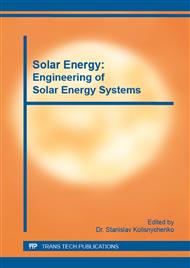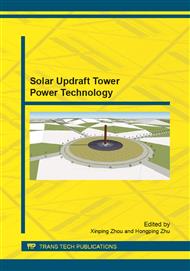p.25
p.35
p.41
p.47
p.57
p.67
p.73
p.87
p.99
The Studies of Optimal Arranging of the Solar Photovoltaic Battery Array and Optimal Matching of Power System for a Parking Garage
Abstract:
The output power of the photovoltaic battery array of a solar parking garage is affected by two factors of arranging form and external conditions. Firstly, a solar parking garage in Qingdao is taken as an example. A simulation model of its solar panel square is established based on Matlab/S-Fcn/Simulink. The GX-120 solar panel with the size of 1250mm×808mm is taken as an example. And the normal external conditions and the principle of maximum output power in one year are also considered. Simulation results based on Matlab/S-Fcn/Simulink demonstrate that solar panels should be put on the dip angle of 30,with the span of 1605mm between two row. 28 solar panels can be arranged on the top of the parking space. Secondly, an experiment setup is established in order to simulate the electricity generating process by solar panels and parking process. Two GX-120 solar panels are employed as power generation device, while two 12V, 195AH storage batteries are employed as energy storage device. A direct 24V electromotor with hydromantic pressure 18MPa device is applied as simulation load, which can demonstrate the ascending and descending process in the parking space. The experiment studies the performance of the solar panels under different weather conditions. Results show that generating capacity of two pieces of panels can make a parking unit work eleven times, five times, one time and six times separately under four kinds of weather conditions (sunny, cloudy, rainy, and foggy day). The energy matching principle is that the parking lot only can provide 6.85 kilowatt for electric vehicles one day in the condition that each parking space parks cars four times every day in order to meet the continuous use of the parking garage. The rest of electricity must be storied in the battery.
Info:
Periodical:
Pages:
99-107
Citation:
Online since:
January 2013
Authors:
Price:
Сopyright:
© 2013 Trans Tech Publications Ltd. All Rights Reserved
Share:
Citation:



